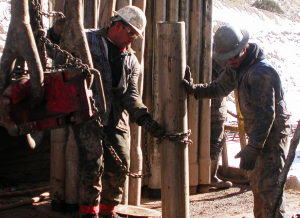
 The deaths of 29 miners at the Upper Big Branch Mine remind us that our energy consumption has a cost, and it is paid in part in human lives. It also reminds us that these deaths aren’t inevitable.
The deaths of 29 miners at the Upper Big Branch Mine remind us that our energy consumption has a cost, and it is paid in part in human lives. It also reminds us that these deaths aren’t inevitable.
The tragic ending to the disaster at the Upper Big Branch Mine serves as a reminder of one of the many tolls of our thirst for energy.
The people of Montcoal, West Virginia would no doubt have been happier if all those satellite trucks had gone away, if all the reporters had stopped pressing microphones at them. If there is a silver lining to this disaster, though, it is that we all know about the tragedy there.
So many who die in the natural gas fields of the West do so anonymously. They die one at a time, in an isolated rig accident. Their names are rarely known. The circumstances of their death are rarely told. But like the miners at the Upper Big Branch, they are dying so we can turn on our lights. Often, they are dying because industry cared more about the resources under the ground than the people who work to get it out.
The environmental costs of our energy thirst is well documented. West Virginia has its heartbreaking legacy of mountains turned to mesas through the horror of mountaintop removal. Rivers and valleys are filled with earth while the mountains are leveled.
The oil and gas industry seems downright sterile in comparison, but those who live in western Colorado have seen the problems that that industry can bring, too. Waste pits are left to leak, or to fill the air with toxic fumes. Groundwater is contaminated. Smog fills the air. Scars are left on the landscape.
Less remembered is the toll of the workers who are injured or die.
The deaths of 29 miners at the Upper Big Branch Mine remind us that our energy consumption has a cost, and it is paid in part in human lives. It also reminds us that these deaths aren’t inevitable.
“It’s clear that more needs to be done” about mine safety, President Obama said after the final fatalities were announced. This year at the Upper Big Branch alone, the mine had repeated problems with methane buildup, the New York Times reports. It racked up eight “substantial violations” in the past 12 months over its methane control plans. Methane monitors that were supposed to be calibrated every month were being calibrated every three months. Regulators stopped work at one section of the mine until the ventilation could be corrected.
“It’s a profession that’s not without risks and danger,” Obama said, “and the workers and their families know this, but the government and their employer know that they owe it to these employees’ families to do everything possible to ensure their safety.”
Last year, a record low year for mining deaths, still claimed the lives of 34 miners.
The risks in the oil and gas industry are no less real. In 2006, amid the West’s gas boom, 20 people died on rigs in the West, according to an investigation by High Country News.
“The machinery in and around a drilling rig can hurt or kill from just about any angle,” wrote investigative reporter Ray Ring in a stirring 2007 story on “the disposable workers of the oil and gas fields.”
“Workers get crushed by rig collapses,” Ring wrote, “they fall off the steel ledges and the maze of catwalks and ladders and walkways, they get caught in spinning chains, winches and cables. Sometimes they get strangled by their own fall-protection harnesses. On or off the rigs, they handle flammables, and sometimes they get fireballed. They succumb to poisonous hydrogen sulfide, which occurs in natural gas before it’s processed; one whiff is fatal. They get slammed by valves and pipes that explode under high pressure. They get hit by lightning, freeze to death and die of heat stroke, because the work takes place outside, and it goes on 24/7, 365 days a year, pretty much no matter what.”
Ring tells the tragic story of Colton Bryant, who fell 26 feet to his death while working on a rig. Bryant wasn’t wearing a safety harness that would have protected him. The company, Patterson-UTI Energy, had failed to put up an inexpensive railing that could have saved his life. It was fined $7,031.
His story is told in Alexandra Fuller’s book, “The Legend of Colton H. Bryant,” which should be required reading for anyone whose home is lit by natural gas.
“Like all Westerns,” she wrote, “this story is a tragedy before it even starts because there was never a way for anyone to win against all the odds out here.”
Maybe not. But the workers in this nation’s mines and rigs at least deserve to have those odds evened out a little. The power that runs the laptop I typed this column on isn’t worth dying for.

